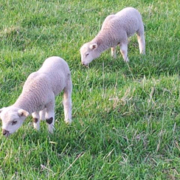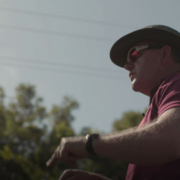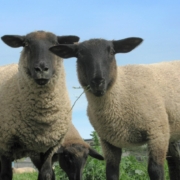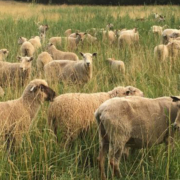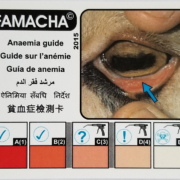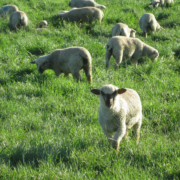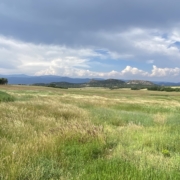Top 5 Lambing Hacks for a Panic-Free Season
 Print This Post
Print This Post
By Linda Poole, Regenerative Grazing Specialist
Like many shepherds, I love and dread lambing. It is mostly pure joy – watching a beautiful ewe polish and murmur to her newborn twins who blink in surprise at the bright world around them, while fleets of older lambs leap and race through green fields where their mommas contentedly graze. But bucolic peace vanishes when it’s o’dark thirty, there’s a ewe looking not quite right, the road to the vet is impassable due to mud, and it looks like a c-section might be necessary. There’s no one to help and I just can’t stand the idea of my sheep in distress. It would be easy to panic!
But over the years I’ve been blessed by mentors whose stories and cautions have soaked so deep into my core that now they are mine too. As a way to pay forward the wisdom so kindly shared with me, here are my top five tips and tools for a panic-free lambing season.
1. Really see. It sure helps to have an inkling of which ewes might lamb soon, and the ewes provide ample clues for attentive shepherds. During lambing I feed hay in bunks so I can stroll quietly behind the girls to observe while they eat. Do they all crowd up to eat, or is one holding back, looking a bit secretive? If there’s a nest dug in the straw, which ewe got up from it? Any ewes circling and sniffing the ground? Any changes to shape and color of the udder or vulva? Taut swelling and a bright flush of color signals lambs coming soon. Ewes might whorfle encouragement to their lambs as labor starts, or they might be suddenly covetous of new lambs belonging to other ewes. Visual and auditory cues will suggest whether you retreat quietly while a ewe lambs unassisted, or whether it is time to intervene.
2. Catching and holding. Gently getting hold of a ewe out on pasture without help of a dog is a skill worth mastering. My Basque mentor taught me to use a leg hook from 12-feet away to firmly catch and hold a leg. Once I’ve got hold of the ewe, I position myself to rock her over on her hip without creating resistance. Once she’s recumbent, the gambrel I’ve been packing in my hip pocket goes around one front leg, over her neck and under the other front leg – and voila, my hands are free but the ewe isn’t! When I’d rather have the ewe up on her brisket but stationary, all it takes is deploying the 55-inch sash tucked in my other back pocket.
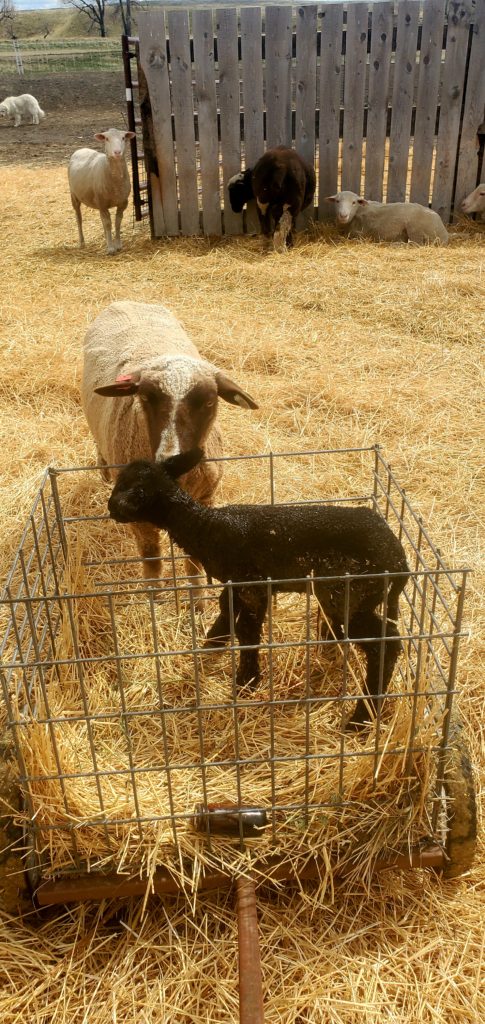
Linda Poole’s Lambulance
3. Portable pen. It’s often easier to take the pen to the ewe than get the ewe to the pen. So, I tie five 6-foot sections of hog panel into a line. I add a few long ties at each end, then accordion the whole thing up and tie it in a corner of the lambing corral. When unfolded, the pen can be shaped however you like, tied to itself as a free-standing pen or tied along a fence for a much bigger space. It can even be used to herd a reluctant ewe and her baby lambs, but for that I’d rather use the “lambulance.”
4. The lambulance. It’s a conundrum to safely carry several slimy newborn lambs at once to a mothering pen while getting a skittish ewe to follow. So, when a friend saw a video of moving baby lambs in a milk crate on wheels, we raided the scrap pile and assembled our own versions. My lambulance is roomy enough for quadruplets yet narrow enough to fit through gates in a crowded lambing barn. Something about the contraption turns new mothers into lambulance chasers, sticking with their babies like glue while the lambs get a comfy ride to the barn.
5. Dip, strip, and clip(board). Once the lambs are on the ground, and while the ewe is restrained, I silently chant “Dip! Strip! Clip!” As soon as possible after birth I completely DIP the lamb’s wet navel in a spice bottle filled with strong (7%) iodine to thwart possible infections. I move to the ewe and gently STRIP her teats to be sure no waxy plug will keep the lamb from sweet success at nursing. If for any reason I think the lamb won’t get enough good colostrum from momma, I tube baby with a full serving of colostrum replacer (not supplement – if it isn’t expensive or commandeered from another of your ewes, it’s not good enough!). Once mother and lambs are settled in their private apartment, I grab my CLIPboard to record all essential data.
I hope this helps you enjoy a fully successful lambing season!
Related Resources:
VIDEO: Linda Poole’s Lambulance
Small Ruminant Sustainability Checklist
This blog is produced by the National Center for Appropriate Technology through the ATTRA Sustainable Agriculture program, under a cooperative agreement with USDA Rural Development. ATTRA.NCAT.ORG.

